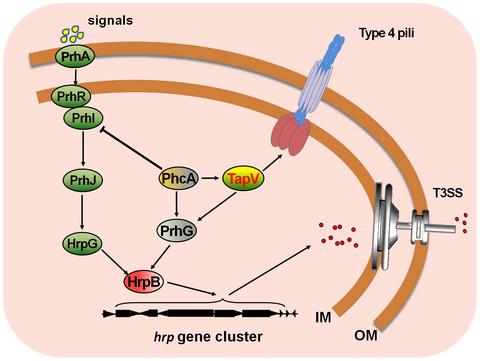当前位置:
X-MOL 学术
›
Mol. Plant Pathol.
›
论文详情
Our official English website, www.x-mol.net, welcomes your
feedback! (Note: you will need to create a separate account there.)
Expression of Ralstonia solanacearum type III secretion system is dependent on a novel type 4 pili (T4P) assembly protein (TapV) but is T4P independent.
Molecular Plant Pathology ( IF 4.8 ) Pub Date : 2020-03-20 , DOI: 10.1111/mpp.12930 Yong Zhang 1, 2 , Liangliang Han 1, 3 , Lichun Zhang 1, 3 , Changzheng Xu 4 , Xiaojun Shi 1, 2 , Yasufumi Hikichi 5 , Kouhei Ohnishi 3
Molecular Plant Pathology ( IF 4.8 ) Pub Date : 2020-03-20 , DOI: 10.1111/mpp.12930 Yong Zhang 1, 2 , Liangliang Han 1, 3 , Lichun Zhang 1, 3 , Changzheng Xu 4 , Xiaojun Shi 1, 2 , Yasufumi Hikichi 5 , Kouhei Ohnishi 3
Affiliation

|
Type IV pili (T4P) are virulence factors in various pathogenic bacteria of animals and plants that play important roles in twitching motility, swimming motility, biofilm formation, and adhesion to host cells. Here, we genetically characterized functional roles of a putative T4P assembly protein TapV (Rsc1986 in reference strain GMI1000) and its homologue Rsp0189, which shares 58% amino acid identity with TapV, in Ralstonia solanacearum. Deletion of tapV, but not rsp0189, resulted in significantly impaired twitching motility, swimming motility, and adhesion to tomato roots, which are consistent as phenotypes of the pilA mutant (a known R. solanacearum T4P‐deficient mutant). However, unlike the pilA mutant, the tapV mutant produced more biofilm than the wild‐type strain. Our gene expression studies revealed that TapV, but not Rsp0189, is important for expression of a type III secretion system (T3SS, a pathogenicity determinant of R. solanacearum) both in vitro and in planta, but it is T4P independent. We further revealed that TapV affected the T3SS expression via the PhcA–TapV–PrhG–HrpB pathway, consistent with previous reports that PhcA positively regulates expression of pilA and prhG. Moreover, deletion of tapV, but not rsp0189, significantly impaired the ability to migrate into and colonize xylem vessels of host plants, but there was no alteration in intercellular proliferation of R. solanacearum in tobacco leaves, which is similar to the pilA mutant. The tapV mutant showed significantly impaired virulence in host plants. This is the first report on the impact of T4P components on the T3SS, providing novel insights into our understanding of various biological functions of T4P and the complex regulatory pathway of T3SS in R. solanacearum.
中文翻译:

Ralstonia solanacearum III型分泌系统的表达依赖于新型4型菌毛(T4P)组装蛋白(TapV),但与T4P无关。
IV型菌毛(T4P)是动植物各种致病细菌中的毒力因子,它们在抽动运动,游泳运动,生物膜形成以及与宿主细胞的粘附中起重要作用。在这里,我们遗传表征(在参考菌株GMI1000 Rsc1986)推定的T4P装配蛋白TapV的功能作用和其同系物Rsp0189,这股58%的氨基酸与TapV同一性,在青枯雷尔氏菌。删除tapV而不是rsp0189会导致抽动运动,游泳运动和对番茄根的粘附力显着受损,这与pilA突变体(已知的茄形毛虫T4P缺陷型)的表型一致。但是,与pilA突变体tapV突变体比野生型菌株产生更多的生物膜。我们的基因表达研究表明,TapV,而不是Rsp0189,对于在体外和在植物中表达III型分泌系统(T3SS,青枯菌的致病性决定因素)都很重要,但它与T4P无关。我们进一步揭示,TapV通过PhcA–TapV–PrhG–HrpB途径影响T3SS表达,这与先前报道的PhcA积极调节pilA和prhG的表达相一致。此外,删除tapV,但不删除rsp0189,显著受损迁移到和移木质部导管寄主植物的能力,但在表面的细胞增殖没有改变青枯烟叶,这是类似的皮拉突变。该tapV突变表现出显著受损致病的寄主植物。这是有关T4P成分对T3SS的影响的第一份报告,为我们对T4P的各种生物学功能以及青枯菌中T3SS的复杂调控途径的理解提供了新颖的见解。
更新日期:2020-03-20
中文翻译:

Ralstonia solanacearum III型分泌系统的表达依赖于新型4型菌毛(T4P)组装蛋白(TapV),但与T4P无关。
IV型菌毛(T4P)是动植物各种致病细菌中的毒力因子,它们在抽动运动,游泳运动,生物膜形成以及与宿主细胞的粘附中起重要作用。在这里,我们遗传表征(在参考菌株GMI1000 Rsc1986)推定的T4P装配蛋白TapV的功能作用和其同系物Rsp0189,这股58%的氨基酸与TapV同一性,在青枯雷尔氏菌。删除tapV而不是rsp0189会导致抽动运动,游泳运动和对番茄根的粘附力显着受损,这与pilA突变体(已知的茄形毛虫T4P缺陷型)的表型一致。但是,与pilA突变体tapV突变体比野生型菌株产生更多的生物膜。我们的基因表达研究表明,TapV,而不是Rsp0189,对于在体外和在植物中表达III型分泌系统(T3SS,青枯菌的致病性决定因素)都很重要,但它与T4P无关。我们进一步揭示,TapV通过PhcA–TapV–PrhG–HrpB途径影响T3SS表达,这与先前报道的PhcA积极调节pilA和prhG的表达相一致。此外,删除tapV,但不删除rsp0189,显著受损迁移到和移木质部导管寄主植物的能力,但在表面的细胞增殖没有改变青枯烟叶,这是类似的皮拉突变。该tapV突变表现出显著受损致病的寄主植物。这是有关T4P成分对T3SS的影响的第一份报告,为我们对T4P的各种生物学功能以及青枯菌中T3SS的复杂调控途径的理解提供了新颖的见解。









































 京公网安备 11010802027423号
京公网安备 11010802027423号